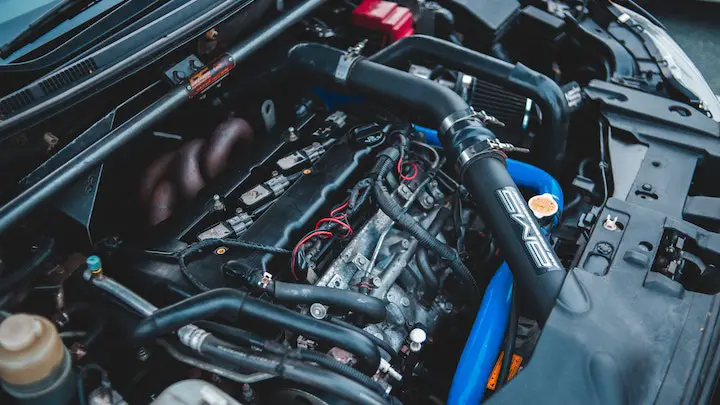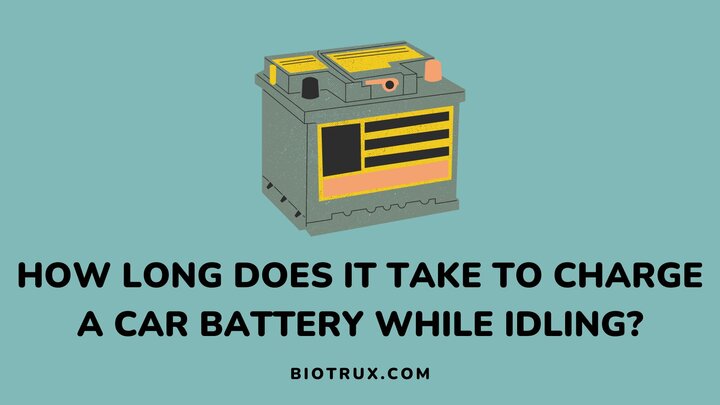To make a good guess of how long a car will take to charge its battery in idle mode, be familiar with the car’s health and age, the alternator’s status, and the engine’s RPMs. Ideally, this process can take about 15 to 30 minutes.
But before that, you might need a jump-start cable to kick-start the battery if it is completely dead. It is a simple process that usually requires the help of another functioning vehicle.
In this guide, I will expose you to how long a car battery should be charged while idling, the process involved, when it is the ideal thing to do, and other ways you can charge your car battery.
How Does an Idling Car Engine Recharge Your Car Battery?

The simple truth about cars is that their batteries get charged whenever the engine is on and running. In other words, driving or letting the engine run in the park will allow the alternator to charge your battery and other electrical components.
So how does this happen? When a car’s engine runs, the alternator rotates to generate electricity inside its coil. This electricity (alternating current) gets converted into a direct current responsible for charging your car’s battery and electrical system.
This is the default process for a healthy car. However, when your car battery loses charge rapidly despite a running engine, your alternator may be faulty.
How Long Does It Take to Charge a Car Battery While Idling?
The whole process can take up to 15 to 30 minutes if you want your car battery to recoup its initial charge. For a full charge, your car may have to idle for hours, which is not a healthy option for batteries or the environment.
If you won’t be using a battery charger (an ideal option), the best you can do is take your car for a few minutes’ drive. This will help your battery attain a full charge faster and without consequences.
You can also use a trickle charger if you plan to park your car for a few weeks or months.
Factors That May Be Responsible For a Longer Idle Charging
I gave an estimated answer to how long it takes a car battery to charge in the idle mode because there are a lot of factors to consider. Major ones include:
1. Status of the alternator
When an alternator is corroded or faulty, the conversion of alternating current to direct current needed to charge your car battery usually becomes slower. If such an alternator is not replaced, it can damage your car battery and the electrical components.
2. Type of car
Newer cars now have numerous power-sucking components like radios, speakers, sensors, and displays. Each of these components also comes with microprocessors, adding to the load on the battery.
Hence, such a car battery takes longer to idle charge. Nevertheless, 30 minutes should do the trick for any car.
How Often Should You Charge a Car Battery By Idling?
Since idle charging is not always the best option for car batteries, I would advise you to do it once every two weeks or twice every two weeks if you wish to maintain the battery’s longevity.
When you turn off your car engine, some power inevitably drains from the battery—a concept known as a parasitic drain. Features like alarm systems, radios, and clocks are usually responsible for parasitic drains or drawers because they do not switch off immediately after you turn off your car.
How To Know If Your Car Has Idled Enough to Charge Battery
You cannot rely on the battery indicator on your dashboard when idle charging. You need a voltmeter. This will help you measure the electrical potential difference, or voltage, between the two points in the battery.
The process is simple, and you can do it yourself if you follow the steps below:
- Turn off your car’s engine.
- A voltmeter has a positive lead and a negative lead. Connect the positive lead to the positive terminal of your battery and the negative lead to the negative end of your battery.
- Go to your meter and check the voltage reading to know the charge status of your battery.
The ideal reading for a fully charged battery should be between 12.4 and 12.8 volts. Anything below this value might indicate that your battery is not fully charged or is deteriorating.
However, if the reading is above 12.8, you have excess voltage. This may be the result of a faulty alternator. One of the easiest ways to drain some of this voltage is to turn on your car’s high beams.
When Not to Idle Charge a Car
While idling a car is an excellent way to help its battery recoup enough charge for normal functions, it might not be ideal for every situation. This works for:
- A car in an enclosed place: When you charge your car battery via idling in an enclosed place, you risk the accumulation of exhaust fumes. These fumes have nowhere to go due to a lack of ventilation and are toxic to human health and the environment.
- A battery with a BMS: Modern cars feature BMS (Battery Management System) designed only to let a battery charge when the right voltage is applied. This means it will take longer for such a battery to charge.
- When maximizing fuel: Charging a car battery by idly running its engine still drains fuel. To maximize fuel, you should opt for other options (in the next section).
Other Ways You Can Recharge Your Car Battery
When idling is not an option for charging your car battery, kindly opt for any of these options. They are safe and do not overwork the alternator.
1. Drive your car
Instead of letting your car battery charge at a spot, you can take it for a spin to ease the stress on the alternator and maximize fuel. 15 to 30 minutes of driving leisurely should get your battery close to a full charge.
2. Use a battery charger
A car battery charger is one of the safest ways to charge your battery. You do not need to start your car engine with this option.
Connect the charger to the battery terminal and a power source.
3. Trickle charge
Using a trickle charger is also an ideal option if you intend to park your car for a few weeks or months without use. This device keeps the battery charged periodically and will not overcharge it.
FAQs
Does sitting idle drain the battery?
Idling can drain your car battery if electrical components such as lights and radio are on.
Idling for long would also cause your engine to overload.
Can the alternator drain the battery while sitting?
A defective or corroded alternator can drain your car battery while at rest. This is because it will continue charging the circuit even when the car is off, resulting in drainage.
How long will a car battery hold a charge without an alternator?
A car battery that hasn’t been fully charged can last anywhere from 5 to 30 minutes. However, this depends on the battery’s capacity and its charge status.
Conclusion
Maintaining a charged battery is crucial to a battery’s lifespan or cycle count. While there are several options, letting a car battery idle remains a cheap and safe way to charge it, as long as you do it in a well-ventilated area.
The alternator is the mastermind of this process. If it is faulty, charging a car battery while idling or driving might be defective. However, if all systems are checked, charging for 15 to 30 minutes every 2 weeks is a good practice.
I hope you found this article helpful. Perhaps your car battery is completely dead, and idle charging is not the next step. Please see how to recharge a completely dead battery.
Thanks for reading.

